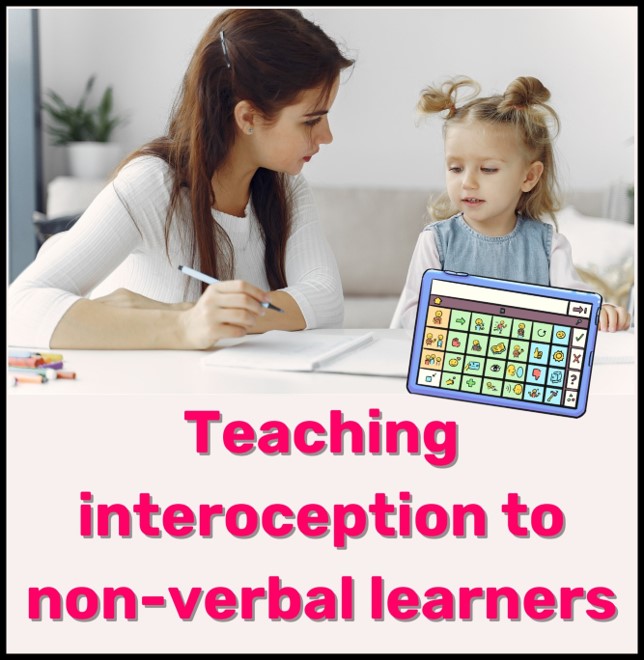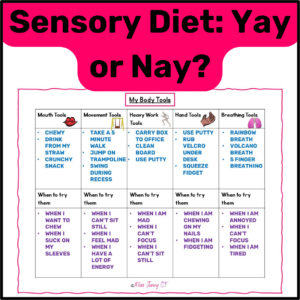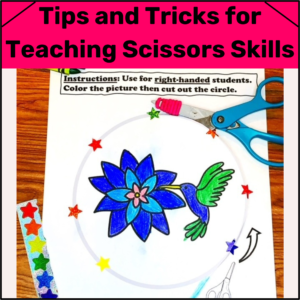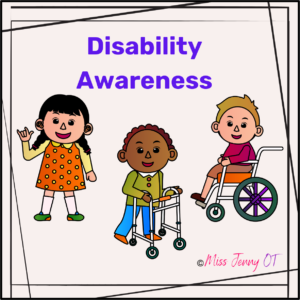Why is teaching interoception to non-verbal learners different than verbal learners?
Teaching interoception skills to non-verbal learners can be more challenging than teaching verbal learners. Some learners who struggle to communicate verbally may also have difficulty understanding language. They may require more time and practice to make the connections between their body sensations and their emotions.
Verbal learners tend to be able to give verbal descriptors for their body sensations, even if they are basic descriptors. Non-verbal learners also have this ability, but it relies on another person first giving them the needed technology.
Many non-verbal learners use low-tech communication options, such as PECS, or other types of visual cards. The cards can be hung from a keyring, velcroed to a chart, shown to them one at a time, or whatever works for that person. These systems typically rely on an adult to prepare. This can include printing out, cutting, and laminating the cards. The adult decides which words to provide.
High-tech options such AAC (augmentative and alternative communication) devices are often used to facilitate communication. These systems also rely on an adult to either program them to include certain words, or to ensure the learner can access the words.
How can we effectively teach interoception using alternative communication?
- The speech language pathologist is an important person on the team. If one is not on the team, consider consulting with one to assist with the language acquisition piece
- The person teaching the skills needs to be aware of the learner’s current communication abilities and methods
- The student needs to have the communication materials prior to beginning the activities (programmed into a device or available as icon cards)
- Start with basic words that the student may already know and be able to use. Words such as wet, dry, hot, and cold, are good ones to start with
- Use familiar activities and embed into the natural environment when possible
- Have multiple copies of icons in different areas to work on generalization
- For all learners, repetition is key
Teaching example
Identifying sensations in the hands is a good first step. There are many activities that can be used as fun awareness builders. The goal of the activities is for the learner to improve their self-awareness of a body part. The ultimate goal is for them to have awareness of internal body sensations (such as changes in heart rate, breathing, bladder, etc.). Building awareness through body parts they can see is more successful than those the cannot see.
- Start with these 6 words-“wet”, “dry”, “hot”, “cold”, “clean” and “dirty”
- Make sure the student has the words in their AAC device, or that icons are available to use
- Start at a sink and model getting your hands wet. Tell the student, “My hands are wet”
- Have them get their hands wet, then tell them “Your hands are wet”.
- Assist the student to indicate, “My hands are wet”. This can be using their AAC device or pointing to icons
- Continue the same process for teaching the other words
- Incorporate fun activities such as doing a “car wash” for toy cards
- As the learner progresses, ask them during activities, “Are your hands wet or dry?” (etc.)
Since the goal is to improve awareness of how the body part feels, try to have the learner tell you how their hands feel without looking at them. Once they have demonstrated success with the skill, move to a different body part.
DISCLAIMER: Please consult with a speech language pathologist for individual learners. If the learner has a different learning style than what is noted here, follow that instead.
***Consider reading my blog post about teaching interoception for more guidelines.
***Grab my free guide to teaching interoception here








